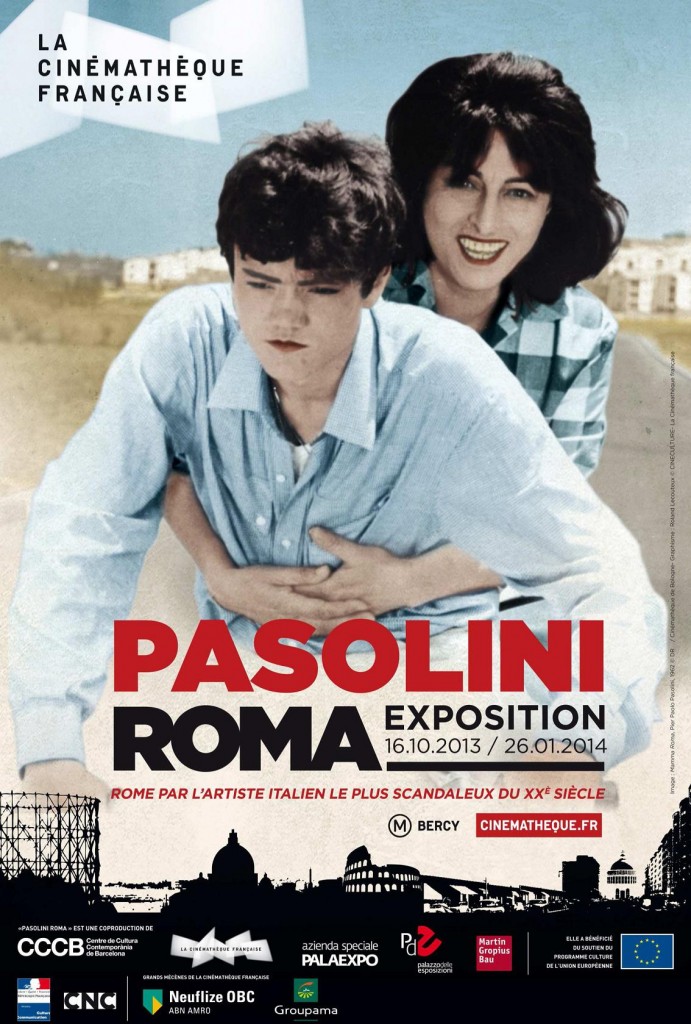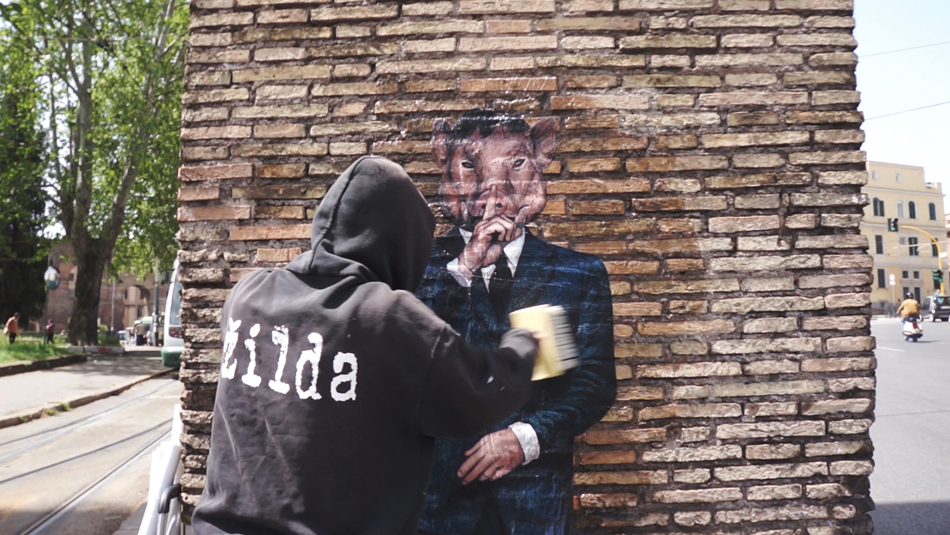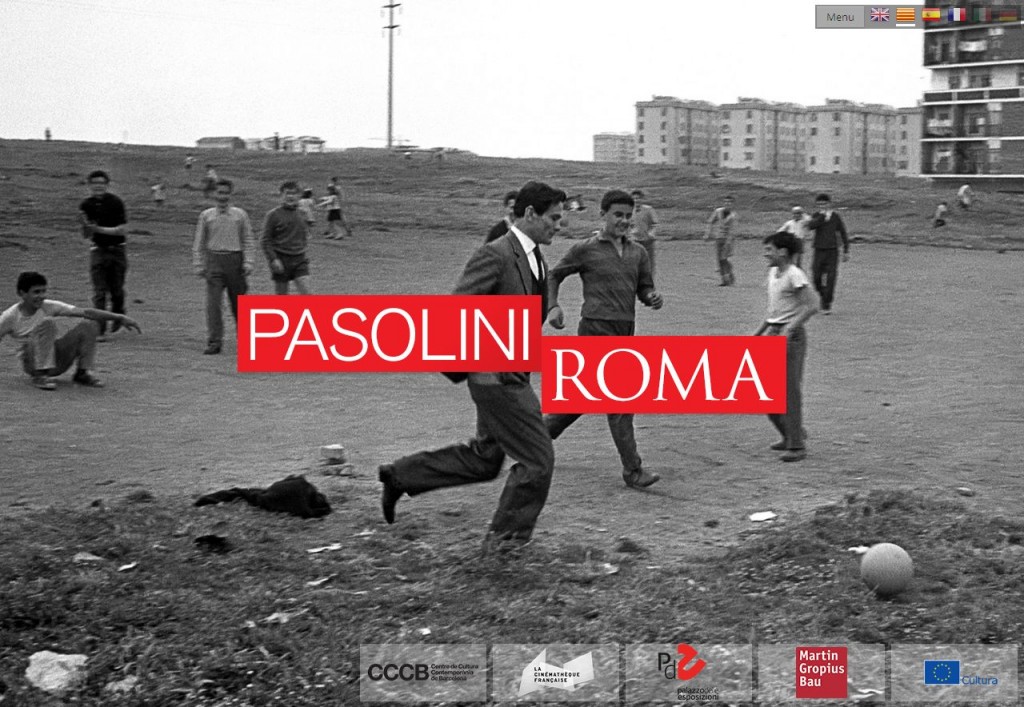Posts Tagged ‘Pasolini Roma’
ARRIVEDERCI “PASOLINI ROMA”
September 9th, 2013 CCCB No CommentsFollowing its stay at the CCCB, the exhibition will tour Paris, Rome, and Berlin
 On Sunday 15 September the exhibition “Pasolini Roma” draws to a close at the Centre de Cultura Contemporània de Barcelona and embarks upon its European tour. The exhibition, the product of a project funded by the European Union and the collaboration of four museums, will continue its journey around the continent and make a first stop in Paris (La Cinémathèque Française) on 14 October this year, then will arrive in Rome for the spring (Azienda Palaexpo- Palazzo delle Esposizioni, 3 March 2014) and reach Berlin in the autumn (Martin Gropius Bau, 11 September 2014).
On Sunday 15 September the exhibition “Pasolini Roma” draws to a close at the Centre de Cultura Contemporània de Barcelona and embarks upon its European tour. The exhibition, the product of a project funded by the European Union and the collaboration of four museums, will continue its journey around the continent and make a first stop in Paris (La Cinémathèque Française) on 14 October this year, then will arrive in Rome for the spring (Azienda Palaexpo- Palazzo delle Esposizioni, 3 March 2014) and reach Berlin in the autumn (Martin Gropius Bau, 11 September 2014).
A week from the close of the exhibition in Barcelona, over 30.000 visitors have taken an interest in the story of Pasolini and Rome, a love affair that began in 1950 when he migrated to the city with his mother and that was tragically cut short in 1975, when he was murdered on the beach at Ostia. The exhibition, curated by Alain Bergala, Jordi Balló and Gianni Borgna, documents 25 years of vital and creative experiences by a prolific author who has left an indelible mark on European culture.
Pasolini Roma online
You can also continue to visit the exhibition online at the website www.pasoliniroma.com, which presents a map of the city of Rome with a series of itineraries connecting emblematic spots and that tour the life and work of Pasolini.
The project’s European team has also set up a blog where its members narrate the exhibition’s work in progress: http://blog.pasoliniroma.com/, tell anecdotes and explain interesting titbits about Pasolini, and file documentation relating to the debates and activities that have been organised to coincide with the exhibition. The CCCB programmed the series of talks “Thinking Differently. Pasolini and the Critique of Mainstream Culture” and invited artist Davide Toffolo to direct a workshop on comics and innovation in Pasolini’s work. The record of all the activities, as well as interviews with the curators and other videos generated by the exhibition can be viewed on the website and on the CCCB’s Vimeo channel. On Twitter, you can follow the chat on the exhibition under the hashtag #PasoliniRoma.
Pasolini Roma – Žilda por lacinematheque
Audiovisual piece created by La Cinemàteque. The artist Žilda talks about how the Rome of Pasolini inspired him to create urban art in the streets of the city. Žilda has created a serie of artistic actions for the exhibition.
(Català) Dacia Maraini: «Pasolini és un model d’intel•lectual compromès per a les noves generacions»
July 16th, 2013 Centre Documentació i Debat No CommentsA Journey to Pasolini’s Rome: online itineraries covering the Italian author’s life and work
July 15th, 2013 Alba Conesa No CommentsIn the last letter that he wrote from his home village of Casarsa, Pier Paolo Pasolini said, “I’ve decided to take my mother to Rome as of tomorrow, at my father’s instigation, and entrust her to my uncle; I’ll be unable to stay in Rome, because my uncle made it clear that he cannot put me up.”
Finally, however, Pasolini did stay in Rome. At the age of 27, after an episode at the centre of a homosexual scandal and his subsequent expulsion from the Italian Communist Party (PCI), on 28 January 1950 the artist began his relationship with the capital.
To his eyes, the city appeared as a place full of contrasts that quickly became a major source of inspiration and that can now be rediscovered by following the writer and filmmaker’s biography on the website of the exhibition “Pasolini Roma”, from the suburbs of Ponte Mammolo to the residential neighbourhood of the EUR (Esposizione Universale Roma).
Web Pasolini Roma, a project developed by the website team of La Cinemàteque Française.
By either using the timeline or alternatively by following any of the ten colour itineraries offered, on the website you will find 50 addresses of places and emblematic periods of Pasolini’s Rome, that include the houses where he lived (green), details of his social and intellectual life (ochre) and spots that inspired his literature (orange).
In the decade of the 1960s and marked in blue, the exhibition website also offers the opportunity to view the sets of the films Accattone, Mamma Roma, Uccellacci e uccellini and La Ricotta.
The website lets visitors browse through ten chronological itineraries of the life of Pasolini. The contents can be viewed in Catalan, Spanish, English, French and soon Italian.
Specifically, the La Ricotta trial, for which Pasolini was initially given a four-month suspended prison sentence, marks the starting point of the red itinerary which follows the author’s political life and covers, for example, the breakdown of relations between Pasolini and the city’ students following the demonstrations of 1968.
Following the timeline, the last itinerary included on the website is the pink itinerary, which tells of the discovery of Pasolini’s body on the beach at Ostia and his funeral at the Campo de’ Fiori, where the people of Rome responded emotionally, eventually turning the funeral into a political demonstration.
French Street Artist Žilda evokes Pasolini
 The website also invites its visitors to immerse themselves in another route: the black itinerary. It follows the works of French street artist Žilda, who, to coincide with the exhibition, has painted graffiti in the corners and streets of Rome that evoke the ghosts of Pasolini.
The website also invites its visitors to immerse themselves in another route: the black itinerary. It follows the works of French street artist Žilda, who, to coincide with the exhibition, has painted graffiti in the corners and streets of Rome that evoke the ghosts of Pasolini.
Scenes from the films Porcile (“Pigsty”, 1969), Il fiore delle Mille i una Notte (“Arabian Nights”, 1974) and Saló (“Salo”, 1975) attract the attention of passers-by from walls, columns and half-hidden nooks of the Italian capital, where some people stop to interact and have their photograph taken with the work.
An artist who resorts to numerous references (such as the Renaissance, Greek mythology and Italian neo-Realism) Žilda has papered with walls of Rome with life-size figures that reproduce and at the same time reinterpret Pasolini’s filmography, but that above all call passers-by to form part of the relationship that was established sixty years ago between Pasolini and the city.









